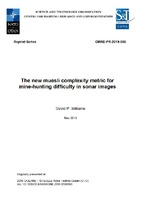| dc.contributor.author | Williams, David P. | |
| dc.date.accessioned | 2019-06-14T12:35:03Z | |
| dc.date.available | 2019-06-14T12:35:03Z | |
| dc.date.issued | 2019/05 | |
| dc.identifier.govdoc | CMRE-PR-2019-008 | en_US |
| dc.identifier.uri | http://hdl.handle.net/20.500.12489/749 | |
| dc.description.abstract | A new image complexity metric has been developed that fuses the concept of lacunarity, a measure of pixel intensity variation, with the notion of spatial information, a quantity that captures edge energy. This new metric, which we call the ?muesli? complexity, successfully quantifies the relative difficulty of performing target detection in synthetic aperture sonar (SAS) images. This has been experimentally validated via the results of a human operator study, as well as the results of an object detection algorithm, using a set of over 3000 SAS images collected in diverse environments. In the former assessment method, it has been observed that the subjective human rankings of image difficulty correlate well with the complexity value. In the latter examination approach, it has been observed that the degrees to which false alarms are generated and true targets are missed by the detection algorithm are each proportional to the complexity value of the image. | en_US |
| dc.format | 7 p. : ill. ; digital, PDF file | en_US |
| dc.language.iso | en | en_US |
| dc.publisher | CMRE | en_US |
| dc.source | In: 2018 OCEANS-MTS/IEEE Kobe Techno-Ocean (OTO), doi: 10.1109/OCEANSKOBE.2018.8559193 | en_US |
| dc.subject | Synthetic Aperture Sonar (SAS) | en_US |
| dc.subject | Sonar images | en_US |
| dc.subject | Image processing | en_US |
| dc.subject | Mine countermeasures (MCM) | en_US |
| dc.subject | Automated Target Recognition (ATR) | en_US |
| dc.subject | Performance estimation | en_US |
| dc.title | The new muesli complexity metric for mine-hunting difficulty in sonar images | en_US |
| dc.type | Reprint (PR) | en_US |
| dc.type | Papers and Articles | en_US |
